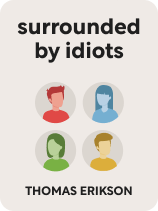

This article is an excerpt from the Shortform book guide to "Surrounded by Idiots" by Thomas Erikson. Shortform has the world's best summaries and analyses of books you should be reading.
Like this article? Sign up for a free trial here .
What are the traits of a Blue-dominant person? For what reasons would you seek out a Blue personality?
In Thomas Erikson’s book Surrounded by Idiots, Blue personalities are described as meticulous, knowledgeable, and cautious. You would seek out a Blue-dominant person at work if you needed to make sure something is organized and done right the first time.
Continue below to learn all about the Blue personality type.
An Overview of the Blue Personality Type
In Surrounded by Idiots, Blue personalities are which Hippocrates refers to as “melancholic.” Like Green types, Blue personalities are introverted—but that’s where the similarities end. Unlike a Green-dominant person, who will go with the flow, the Blue personality is meticulous, deliberate, and cautious. Erikson says that Blue types can be seen from the outside as know-it-alls and “negative Nancies.”
Blue Personalities Are Meticulous
Blue-dominant people are extremely organized. Erikson says they have a place for everything, know where every cent goes, and keep detailed schedules. It would not be unusual for a Blue type to plan meals weeks in advance.
Blue personalities are detail-oriented. Erikson says they live for fine print, and they would never sign a contract without reading every word and making adjustments. While a Red type will want to get started right away, a Yellow personality will go with their gut, and a Green type will agree if everyone else does, Erikson says a Blue-dominant person needs to have control over the situation before starting.
Blue types value quality over speed, and they like to make sure that everything is perfect. Erikson says engineers and other detail-oriented professionals are often Blue. They believe that a task is only worth doing if it’s done perfectly and that shoddy work is never an option.
| The Difference Between Being Meticulous and Having OCD The term “OCD” has become slang for perfectionism, extreme cleanliness, and detail-orientation. However, obsessive-compulsive disorder isn’t a personality trait—it’s a debilitating disorder characterized by high anxiety (not just discomfort) along with unwanted obsessions and rituals. Consider two (of the many) distinctions: Obsession: A person without OCD might discover a new song or show that they enjoy and engage in it obsessively for days or weeks on end. By contrast, “clinical obsession,” which is what those with OCD experience, is when unwelcome and intrusive impulses or ideas plague the person’s every thought. Cleanliness and organization: People without OCD feel at their best when their environment is spotless, and they may or may not enjoy cleaning. Those with OCD, however, often believe that something catastrophic will happen if their surroundings aren’t their version of “perfect.” |
Blue Personalities Are Deep Thinkers
Blue types are knowledgeable but don’t show off what they know. Rather, Erikson says they’re likely to display their knowledge only when they feel it’s necessary. For instance, they’d speak up to correct a mistake they overhear. Erikson adds that Blue personalities are so knowledgeable because they research topics in great depth. For example, while a Red type might make a passing comment about a football game, the Blue-dominant person watched the game, studied old stats, and also read the star player’s biography.
Erikson goes on to say that if a Blue type is speaking about a topic, she probably knows more about it than you do. People with this personality type won’t speak up unless directly asked. For example, picture a classmate who knew every answer but never raised her hand. That person is likely a Blue.
(Shortform note: Quiet people are often misinterpreted as shy, but the two are not the same. To be shy is to feel nervous or intimidated in the presence of others and to fear embarrassment or disapproval. It is a state of being, not a personality trait. On the other hand, some people are quiet not because they are timid, but because they prefer to listen and observe. For them, it’s part of their personality. Keanu Reeves is no stranger to this topic. He has expressed frustration with the constant question of “why” he is so quiet. He explains that this is simply how he functions.)
Blue Personalities Are Cautious
Blue types rarely take risks. Erikson says if they do take a risk, it means they thought it through and have already calculated the level of danger. If they’re unable to predict the risk, they’re unlikely to take a chance on the activity. Blue personalities prefer to use proven methods over new ones.
(Shortform note: In the Myers-Briggs model, this trait most closely resembles ISTJ and ESTJ. Both of these types avoid unproven strategies and opt instead for the most efficient tried-and-true routes. They are willing to change course, however, if given enough time to research all options.)
Seek a Blue-Dominant Person If…
If you need something done right and aren’t in a hurry, Erikson says you should find a Blue-dominant person. A coworker or friend with this personality type will also be helpful if you need someone to proofread a piece of writing or give honest feedback. He will be sure to point out where you can improve.
Erikson lists famous Blue personality types, including Bill Gates and Albert Einstein.
Negative Perceptions of Blue Personality Types
In the DISC model, Erikson’s “Blue” aligns with the “Compliant” personality, which is reliable but leaves little room for flexibility. Erikson says others may view those with this personality type as cold-hearted and negative know-it-alls.
The Perception: Blue Personalities Are Cold-Hearted
Blue-dominant people like to have space—physically and emotionally. People with this personality type need to know someone really well before opening up about their own lives. They tend to have a few close friends rather than a large social circle, and they prefer to spend time alone or with their families. Their body language is quite closed off(don’t expect a hug) and they aren’t ones for small talk. For these reasons, others often perceive Blues to be cold and emotionless.
(Shortform note: “Avoidant attachment” is a term psychologists use to describe people who either avoid relationships or keep their partners at arm’s length. They might even sabotage their relationships as a defense mechanism against being left first. This attachment style is often the result of unresolved childhood trauma, such as abandonment. There is an important distinction, however, between avoidant attachment and the personality trait Erikson describes here: Blue personality types are closed off until they form a deeper relationship, and people with avoidant attachment are closed off within their deepest relationships.)
The Perception: Blue Personalities Are Negative
Blue personalities call themselves “realists,” but Erikson says other color types view them as pessimists. This is because Blues are quick to identify problems but rarely offer solutions(that’s Red and Yellow types’ territory). For example, imagine you present a project proposal in a meeting and ask for feedback. The Green personalities will stay quiet, the Red and Yellow personalities will offer next steps, and the Blue types will point out all the areas you went wrong. This behavior can drag down morale, but Erikson says the Blue personalities believe they’re being helpful.
(Shortform note: There is a common adage in business: “Don’t bring me problems, bring me solutions.” The goal is to avoid a culture of toxic complaining, but while well-intentioned, this approach creates unique problems. The more complex an issue, the harder it is to come up with a solution, and some problems need an all-hands-on-deck approach. “Solution-only thinking” stifles cooperative problem-solving and intimidates employees into not bringing up an issue until it’s a full-blown crisis. When you create a safe environment to discuss problems, more effective solutions can come to light while the issue is still small.)
The Perception: Blue Personalities Are Know-It-Alls
Erikson says that because Blue-dominant people areso research-oriented, they know a lot about every situation they enter ahead of time. This preparedness leads Blue personalities to distrust or dismiss other people’s advice. For example, if a Blue type has decided to run a marathon for the first time, she’ll research the best shoes, the most optimal training schedule, the requirements for entering the race, and so on—all before she goes on her first run. So if you—an experienced runner—try to give her advice, don’t be surprised if she waves you off. Erikson says Blue personalities only take advice from those they deem to be experts, and it takes a lot for them to consider someone an expert.
(Shortform note: If someone asks for your advice on a personal matter but doesn’t take it, should you be insulted? Psychologists say no. Nine times out of 10, they say, when someone asks for your advice, she is really attempting to feel better. Often, she’s either seeking validation for what she’s already decided, or using the opportunity to vent. Only about 10% of the time is the person actually taking your opinion into consideration.)

———End of Preview———
Like what you just read? Read the rest of the world's best book summary and analysis of Thomas Erikson's "Surrounded by Idiots" at Shortform .
Here's what you'll find in our full Surrounded by Idiots summary :
- A detailed look at Thomas Erikson's four personality types
- How to navigate conflicts with coworkers
- How to effectively communicate and collaborate with bosses, employees, and colleagues






